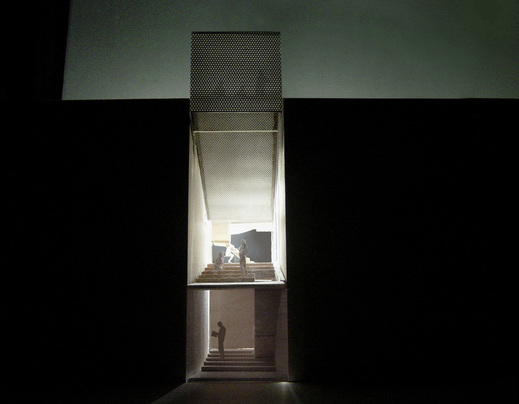ASA Information Center
Thai shop houses do not encourage freedom of movement. They are narrow, small, and extruded vertically over three to four very steep levels. Nonetheless, the Association of Siamese Architects (ASA) conducted a competition to design their information center within one such shop house. As though the envelope was not challenging enough on its own, they demanded more program space than the existing building could physically contain in its original state. We were left, then, with two questions: one, how do you make people want to escalate through the building and, two, how can you expand the building without exceeding its original volume?
We found our solution in the building’s original problem: the stairs. If we removed the stairs, we could muster enough area for the required programs, and if we converted the floor plates into systems of giant, 1.5m wide stairs, then even a quotidian use of any of the programmatic spaces would automatically seduce the visitor into vertical moving through the center. The width of the tread is sufficient for exhibition space, seating, dining and library space. Because the vertically cascading floor plates were never perfectly horizontal for more than 1.5m at a time, the volumes between each flight of stairs/plates—the stories in a conventional building—would begin at one landing with 3m of height but, as the flights spread apart from one another, would expand into a much larger arc, thereby creating disproportionately large volumes in a small building. A visitor to the ASA center would have no sense that they were in a 120 sqm space distributed over 4 stories.
We found our solution in the building’s original problem: the stairs. If we removed the stairs, we could muster enough area for the required programs, and if we converted the floor plates into systems of giant, 1.5m wide stairs, then even a quotidian use of any of the programmatic spaces would automatically seduce the visitor into vertical moving through the center. The width of the tread is sufficient for exhibition space, seating, dining and library space. Because the vertically cascading floor plates were never perfectly horizontal for more than 1.5m at a time, the volumes between each flight of stairs/plates—the stories in a conventional building—would begin at one landing with 3m of height but, as the flights spread apart from one another, would expand into a much larger arc, thereby creating disproportionately large volumes in a small building. A visitor to the ASA center would have no sense that they were in a 120 sqm space distributed over 4 stories.

